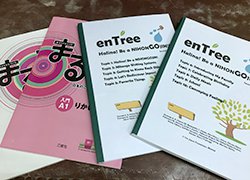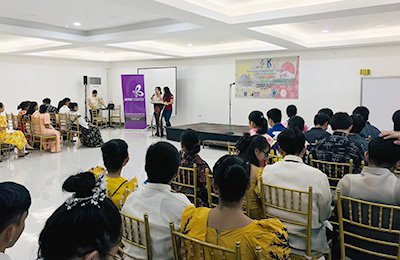2019 Japanese-Language Assistants’ Report: In the Midst of Diverse Japanese Language Education
The Japan Foundation, Manila
MURAKAMI Nami
It's already been a year since I was assigned to the Japan Foundation, Manila (hereafter referred to as “JFM”). I am a member of the secondary education team and mainly provide support to high school teachers. JFM's Japanese-Language Assistants (hereafter referred to as "Assistants") are responsible for a wide range of tasks, but I would like to introduce two tasks that I found particularly fulfilling.
Study Online!

Textbooks used in the training
In secondary education in the Philippines, teachers of other subjects, such as English and social studies, go through a three-year training program before starting to teach as Japanese language teachers. For this reason, JFM's secondary education team conducts a five-week summer intensive training program and monthly supplementary training programs during April and May, which is the summer vacation in the Philippines. In this training, we analyze the Philippine secondary education teaching material "enTree Halina! Be a NIHONGOJIN!!," show how to use realia, and conduct mock classes. In addition, Japanese language study is conducted using the textbook "Marugoto: Japanese Language and Culture," and the training is designed for the teachers to be able to teach Japanese as Japanese language teachers at their high schools after the training.
In 2018, in addition to the usual class-based training, we provided third-year trainee teachers with self-study using "JF Japanese e-Learning Minato" and Japanese lessons using online tools. The high school teachers to be trained are spread out over a wide area, and commuting may require several hours of travel to the training site. For such a teacher, online lessons seemed to be very attractive. The online lessons focus on speaking using the sentence patterns and vocabulary learned through self-study. The lessons with Filipino teachers, who love to talk, are always over in a flash.
The teachers, who are just as energetic as when they were taking in-person classes, learn Japanese through their computer screens. I am also thinking that I need to respond to the fact that the way of support is gradually changing.
Nihongo-jin Forum (Japanese Speakers' Forum) in the Philippines, with Laughter, Tears, and Excitement
Have you ever heard of the term "Nihongo-jin"?
The term "Nihongo-jin" refers to people in the international community who have the intention to use Japanese to accomplish something and communicate in Japanese for that purpose. JFM and the Kamenori Foundation co-host the Nihongo-jin Forum (Japanese Speakers' Forum) in the Philippines (hereafter referred to as "JSFP") every January to provide an opportunity for mutual exchange between Japanese and Filipino junior and senior high school students.
The secondary education team in charge of the JSFP holds numerous consultations several months before the forum to design the theme and program. The theme of the 2019 forum was "Mottainai," or "Wastefulness," and we discussed the issue of waste in our daily lives. Before deciding on this theme, the entire secondary education team prepared a draft program plan and discussed the contents. The team worked together to come up with ideas on what we want the participants to notice, what kind of input they need, and how to set up opportunities for mutual exchange between Filipino and Japanese junior and senior high school students.
Based on the completed program, a three-day forum was held. The main part that the Assistants were in charge of was the Japanese language and debriefing sessions. In the Japanese session, I gave picture cards to the Japanese students and created an opportunity for them to teach Japanese to the Filipino students. Most of the Japanese students were teaching Japanese for the first time, and they seemed to enjoy it very much. The debriefing session was the part that I put the most effort into preparing for, in order to deepen the various things they had encountered and learned in the short period of just three days. It was a valuable time for the participating students to share what they experienced and learned together, including what they enjoyed, what they struggled with, what they worked hard on, and what they overcame.

Time to dress up in traditional costumes and interact with each other!
For the Philippine students, it was their first opportunity to meet Japanese people, and for the Japanese students, it was a chance to communicate with each other using simple Japanese and English. All of the participants displayed a wide variety of expressions during the three days, from sincere enjoyment of mutual exchange to frustration at times when communication did not go well. Being able to see this kind of growth in people is one of the best parts of working on the secondary education team.
JFM has a Japanese-language course team, an EPA training team, and a secondary education team to provide a variety of Japanese language education experiences. The Philippines may be the most passionate country in the world right now, where you can meet learners who are studying Japanese with various emotions. As a member of the team, Assistants are also involved in the daily tasks.
- What We Do Top
- Arts and Cultural Exchange [Culture]
- Japanese-Language Education Overseas [Language]
- Japanese-Language Education Overseas [Language] Top
- Learn Japanese-language
- Teach Japanese-language
- Take Japanese-Language Test
- Know about Japanese-language education abroad
- The Japanese-Language Institute, Urawa
- The Japanese-Language Institute, Kansai
- Japanese-Language Programs for Foreign Specified Skilled Worker Candidates
- Japanese Language Education for Japanese Children Resident Overseas and for the Descendants of Migrants
- Archives
- Japanese Studies and Global Partnerships [Dialogue]
- JF digital collection
- Other Programs / Programs to Commemorate Exchange Year
- Awards and Prizes
- Publications
